A practical guide to bird watching in Sonoma County, California
(Unless otherwise indicated, all phone numbers are in the 707 area code)
A practical guide to bird watching in Sonoma County, California
(Unless otherwise indicated, all phone numbers are in the 707 area code)

Sonoma County Bird Finder and Species Notes
PASSERINES (perching birds, song birds)
Also see NON-PASSERINES, PELAGIC SPECIES, and INTRODUCED SPECIES
(Key to color code at bottom of page)
TYRANT FLYCATCHERS (Family Tyrannidae)
Flycatchers (genus Contopus)
•*Western Wood Pewee: Sum, Pine Flat Rd., Santa Rosa Creek at Willowside Rd., Spring Lake,
•*Olive-sided Flycatcher: Sum, Annadel State Park, Hood Mountain Regional Park, Sugarloaf Ridge State Park
Empidonax and Sayornis flycatchers

•*Black Phoebe: YR, our most common flycatcher. Spring Lake, Lake Ralphine, Place to Play Park, Nagasawa Park, Hole in the Head, Ragle Ranch Park,
•*Say's Phoebe: Win, Jenner Headlands, Doran Beach, Tolay Lake Regional Park, Shollenberger Park, Ellis Creek Water Treatment Facility
•Willow Flycatcher: Autumn migrant, Spring Lake, Owl Canyon, Hole in the Head
Myiarchus flycatchers
•*Ash-throated Flycatcher: Sum, Spring Lake, Lake Ralphine, Santa Rosa Creek at Willowside Rd., Helen Putnam Regional Park
Kingbirds (genus Tyrannus)
•*Western Kingbird: Sum, Bodega Bay, Sugarloaf Ridge State Park, Shollenberger Park, Ellis Creek Water Treatment Facility
•Tropical Kingbird: SVAR. Shows up rarely but fairly regularly. Usually in Autumn. Typically one or two sightings a year. Reported at Whaleship Rd. October 2012. Bodega Bay near Doran Regional Park entrance in 2011. Reported at Westside Park, Bodega Bay in Nov. 2010.

SHRIKES (Family Laniidae)

•*Loggerhead Shrike: YR, but uncommon and numbers apparently declining. Seen sporadically at Bodega Bay, but mostly seen in the southeast of the county--Ramal Rd., Hudeman Slough, Tolay Lake Regional Park, Viansa Winery, Sonoma Baylands Trail, Port Sonoma (Pictured here)
•Northern Shrike: SVAR. A few recorded sightings in the winter months

VIREOS (Family Vireonidae)

•*Hutton's Vireo: YR, common in live oak, blue oak, douglas fir forests. Often confused with Ruby-crowned Kinglet. Jenner (Willow Creek Rd.), Santa Rosa Creek at Willowside Rd., Helen Putnam Regional Park, Place to Play Park, Spring Lake, Annadel State Park, Channel Dr., Sonoma State University campus. (Pictured here)
•*Warbling Vireo: Sum, Common throughout the county in appropriate woodland habitat. Santa Rosa Creek at Willowside Rd., Channel Dr., Annadel State Park, Lake Ralphine, Spring Lake, Sugarloaf Ridge State Park, Hood Mountain, Sonoma State University campus
•Cassin's Vireo: Sum, Present throughout the county in appropriate woodland habitats, but not abundant. Spring Lake, Annadel State Park, Channel Dr., Sugarloaf Ridge State Park, Mt. Hood

CROWS, RAVENS, JAYS and MAGPIES (Family Corvidae)

•*American Crow: YR, Common in most of the county. Spring Lake, Place to Play Park, urban and suburban areas
•*Western Scrub-jay: YR, Common in most of the county. Spring Lake, Bodega Harbor, Channel Dr., Annadel State park, Sugarloaf Ridge State Park
•*Common Raven: YR, mostly at higher elevations, becomes more common in Winter (Pictured here)
•*Steller's Jay: YR, common in conifer/oak forest, mostly at higher elevations, becomes more common in Winter. Annadel State Park, Spring Lake, Sugarloaf Ridge State Park

LARKS (Family Alaudidae)
LARKS
•*Horned Lark: YR, but uncommon and numbers apparently declining.

SWALLOWS and MARTINS (Family Hirundinidae)

•*Barn Swallow: Sum, Common in much of the county. Spring Lake, Sugarloaf Ridge State Park, Place to Play Park, Shollenberger Park, Ellis Creek Water Treatment Facility
•*Violet-green Swallow: Place to Play Park, Riverfront Regional Park, Santa Rosa Creek at Willowside Rd., Spring Lake, Shollenberger Park
•*Cliff Swallow: Sum, Santa Rosa Creek at Willowside Rd., Jenner, Spring Lake, Lake Ralphine
•*Tree Swallow: Spring, Sum, Ragle Ranch Park, Spring Lake, Shollenberger Park, Lake Ralphine, Santa Rosa Creek at Willowside Rd. (Pictured here)
•*Northern Rough-winged Swallow: Sum, Ragle Ranch Park, Spring Lake, Santa Rosa Creek at Willowside Rd., Shollenberger Park, Ellis Creek Water Treatment Facility
MARTINS
•Purple Martin: Bridge at the mouth of the Gualala River, sporadic sightings around the county

CHICKADEES and TITMICE (Family Paridae)

•*Oak Titmouse: YR. Wooded areas throughout the county, common feeder visitor
•*Chestnut-backed Chickadee: YR, Spring Lake, Annadel State Park, Channel Dr., Arroyo Sierra Dr., Brush Creek Trail, present in wooded areas throughout the county, common feeder visitor. (Pictured here)

LONG-TAILED TITS and BUSHTITS (Family Aegithalidae)

•*Bushtit: YR, Present in wooded areas throughout the county

NUTCHATCHES AND CREEPERS
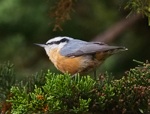
•*White-breasted Nuthatch: YR, Present in wooded areas throughout the county, occasional feeder visitor, especially in winter. Favors mixed broadleaf forest
•*Red-breasted Nuthatch: YR, Sporadic around the county in suitable wooded areas. Bodega Harbor, Ida Clayton Rd., Pine Flat Rd., Coleman Valley Rd., Skaggs Spring Rd.
•Pygmy Nuthatch: YR, but confined to higher elevations with coniferous forest. Ida Clayton Rd., Armstrong Redwoods State Reserve. (Pictured here)
Family Certhiidae (Creepers)
•*Brown Creeper: YR, Spring Lake, Arroyo Sierra Dr., Strawberry School Park, Present in wooded areas throughout the county, occasional feeder visitor

WRENS AND DIPPERS
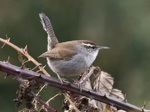
•*Bewick's Wren: YR, our most common wren. Hole in the Head, Lake Ralphine, Spring Lake, Annadel State Park, Channel Dr., Helen Putnam Regional Park. (Pictured here)
•*Marsh Wren: YR, Shollenberger Park, Ellis Creek Water Treatment Facility, Bodega rail ponds, Spring Lake
•*House Wren: Mostly Sum, Annnapolis Rd., Pine Flat Rd., Sugarloaf Ridge State Park, Annadel State Park
•*Pacific Wren (formerly Winter Wren): YR, but mostly confined to moist undergrowth in forested areas of north county. Annapolis Rd., Pine Flat Rd., Sugarloaf Ridge State Park
•*Rock Wren: SVAR Pine Flat Rd., Sugarloaf Ridge State Park
•*Canyon Wren: YR, but rare and restricted to cliff faces at higher elevations mostly in the eastern part of the county
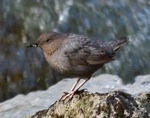
•*American Dipper: YR, but confined to fast, rocky streams. Big Austin Creek, Dry Creek, Big Sulphur Creek, North Geysers Rd., King Ridge Rd.

KINGLETS (Family Regulidae)
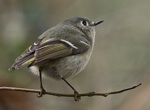
•Ruby-crowned Kinglet: Mostly Win, but also early spring, late autumn. Spring Lake, Lake Ralphine, Crane Creek Regional Park, Ragle Ranch Park, Bodega Bay rail pond area, Hole in the Head, Santa Rosa Creek at Willowside Rd. (Pictured here)
•*Golden-crowned Kinglet: YR, but not abundant. Mostly confined to mature conifer forest. More common in early autumn to late spring. Bodega Bay, Annadel State Park, Channel Dr., Helen Putnam Regional Park, Spring Lake

SYLVIID WARBLERS (Family Sylviidae)
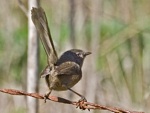
•*Wrentit: Jenner (Willow Creek Rd.), Campbell Cove, Sugarloaf Ridge State Park, Cavedale Rd., Spring Lake, Shollenberger Park, Pine Flat Rd.

GNATCATCHERS (Family Polioptilidae)
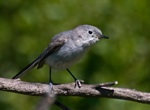
•*Blue-gray Gnatcatcher: Sum, mostly at higher elevations in eastern part of the county. Sugarloaf Ridge State Park, Annadel State Park, Pine Flat Rd., Hood Mountain

THRUSHES (Family Turdidae)

•*Western Bluebird: YR, Jenner, Jenner Headlands, Ragel Ranch Park, Spring Lake, Lake Ralphine, Santa Rosa Rural Cemetery, Nagasawa Park, Annadel State Park, Sugarloaf Ridge State Park, Shollenberger Park, Ellis Creek Water Treatment Facility
•*American Robin: YR, but mostly Win. Bodega Bay, Ragle Ranch Park, Laguna De Santa Rosa, Santa Rosa Rural Cemetery, Place to Play Park, Nagasawa Park, Sonoma State University campus, Shollenberger Park, Ellis Creek Water Treatment Facility. Pictured here)
•Hermit Thrush: YR, but more common in Win. Hole in the Head, Armstrong Woods State Park, Ragel Ranch Park, Spring Lake, Channel Dr.
•Swainson's Thrush: Sum, Prefers moist forested areas at lower elevations. Willow Creek Rd., Santa Rosa Creek at Willowside Rd., Spring Lake, Sonoma State University campus
•Varied Thrush: Irruptive, sporadic. Win, Many sightings in 2011. They seemed to be everywhere in 2006-2007. Ragle Ranch Park, Spring Lake, Lake Ralphine
•Townsend's Solitaire: Win, mostly confined to higher elevations. North peak of Mt. St. Helena appears to be the most reliable spot. Mt Hood.
•Mountain Bluebird: SVAR. Single birds have been recorded occasionally in the winter months at Laguna de Santa Rosa (Jan. 10), Dry Creek Rd. (Feb. 07), Jack London State Park (Feb. 06)

MOCKINGBIRDS and THRASHERS (Family Mimidae)
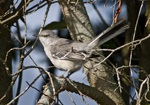
•*Northern Mockingbird: YR, common in suburban and urban locations around the county, Bodega Harbor, Ragle Ranch Park, Spring Lake, Lake Ralphine, Sonoma State University campus. (Pictured here)
•*California Thrasher: YR, but not abundant. East county upland areas: Pine Flat Rd., Sugarloaf Ridge State Park, Ida Clayton Rd., Mt. Hood, Cavedale Rd., Mt. St. Helena

STARLINGS (Family Sturnidae)
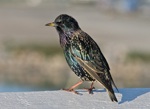
•*European Starling: Common in suburban and urban locations around the county, parks, agricultural land, grassy areas with light woods nearby. Jenner, Bodega Harbor, Spring Lake, Lake Ralphine, Sometimes seen in flocks of thousands in rural areas.

WAGTAILS and PIPITS (Family Motacillidae)
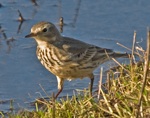
•American Pipit: Mostly Win, Ellis Creek Water Treatment Facility, Shollenberger Park

WAXWINGS (Family Bombycillidae)
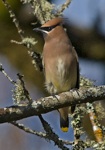
•Cedar Waxwing: Mostly autumn through spring, not uncommon in small to large flocks in urban and suburban settings, Spring Lake, Sonoma State University campus, Place to Play Park, Lucchesi Park, Shollenbergr Park (Pictured here)
•Bohemian Waxwing: SVAR Irruptive at long intervals. Last recorded sighting appears to have been 1969

SILKY FLYCATCHERS (Family Ptilogonatidae)
SILKY FLYCATCHERS
•Phainopepla: SVAR, Only a few sightings have been recorded.

LONGSPURS and SNOW BUNTINGS (Family Calcariidae)
LONGSPURS
•Lapland Longspur: SVAR Win, has been seen at Jenner Headlands Preserve

WOOD WARBLERS (Family Parulidae)
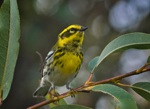
•*Yellow-rumped Warbler (Myrtle): Win, abundant throughout the county in suitable habitat (distribution of the two types is different from place to place)
•*Yellow-rumped Warbler (Audubon's): Win, abundant throughout the county in suitable habitat (distribution of the two types is different from place to place)
•*Orange-crowned Warbler: Spring migration, Sum, Autumn migration, Ellis Creek Water Treatment Facility, Spring Lake, Lake Ralphine, Crane Creek Regional Park, Ragle Ranch Park, Arroyo Sierra Circle, Bodega Bay
•*Common Yellowthroat: Shollenberger Park, Ellis Creek Water Treatment Facility
•Townsend's Warbler: Win, Spring, Autumn, Lake Ralphine, Strawberry School Park, Arroyo Sierra Dr., Spring Lake (Pictured here)
•*Yellow Warbler: Lake Ralphine, Strawberry School Park, Arroyo Sierra Dr., Melita Rd., Channel Dr.
•*Wilson's Warbler: Lake Ralphine, Spring Lake, Strawberry School Park, Arroyo Sierra Dr., Channel Dr.
•*Black-throated Grey Warbler: Spring, Autumn migration, Lake Ralphine, Spring Lake, Strawberry School Park
•*Nashville Warbler: Spring and autumn migration. Mostly restricted to higher elevations in the eastern part of the county. Ida Clayton Rd., Pine Flat Rd.
•*Hermit Warbler: Sum. Mostly in dense woods in extreme northwest part of the county, but shows up at Spring Lake and elsewhere occasionally.
•*Yellow-breasted Chat: Sum, but uncommon and mostly restricted to dense riparian woodland habitats
•Black-and-white Warbler: Has been seen at Spring Lake (September 2012, December 2011), Owl Canyon (October 2011, September 8-9, 2010), Also turns up at Pt. Reyes (in neighboring Marin County) during migration.
•*MacGillivray's Warbler: Has been seen at Spring Lake (September 2012), Arroyo Sierra Dr. (Sep. 2010), Owl Canyon (Sep. 2010, Sep. 2008), Campbell Cove (Sep 2010)
•Palm Warbler: Win, but rare. Ordinance Rd., Santa Rosa (Feb. 2011). Has been seen at Shollenberger Park (April and Nov. 2005). Seen sporadically at Bodega Bay sites.
•Magnolia Warbler: Campbell Cove (Sep. 2010, Oct. 2010), Bodega Marine Lab trees (Oct. 2004)
•Black-throated Blue Warbler: Owl Canyon, Campbell Cove, Bodega Marine Lab trees

EMBERIZIDS (Family Emberizidae--TOWHEES, SPARROWS, JUNCOS)
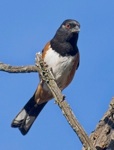
•*California Towhee: YR, Very common in appropriate habitat around the county, including suburban settings. Regular feeder visitor. Arroyo Sierra Dr., Strawberry School Park, Ragel Ranch Park, Lake Ralphine, Spring Lake, Annadel State Park, Sugarloaf Ridge State Park, Sonoma State University campus, Shollenberger park, Ellis Creek Water Treatment Facility
•*Spotted Towhee: YR, but seems more common in WinVery common in appropriate habitat around the county, including suburban settings. Regular feeder visitor. Arroyo Sierra Dr., Strawberry School Park, Ragel Ranch Park, Laguna De Santa Rosa, Lake Ralphine, Spring Lake, Annadel State Park, Sugarloaf Ridge State Park, Sonoma State University campus, Helen Putnam Regional Park, Shollenberger Park, Ellis Creek Water Treatment Facility (Pictured here)
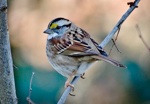
•*Song Sparrow: YR, common throughout the county. Favors open brushy areas, forest edges, and marshy areas. Jenner, Bodega Bay area, Ragel Ranch Park, Santa Rosa Creek at Willowside Rd., Laguna de Santa Rosa, Place to Play Park, Nagasawa Park, Lake Ralphine, Spring Lake, Channel Dr., Shollenberger Park, Ellis Creek Water Treatment Facility.
•*House Sparrow: YR, common throughout the county near human habitation.
•Golden-crowned Sparrow: Common in the winter months. Frequent winter feeder visitor. Hole in the Head, Ragle Ranch Park, Lake Ralphine, Spring Lake, Sonoma State University campus., Ellis Creek Water Treatment Facility, Shollenberger Park, Hudeman Slough
•*White-crowned Sparrow: YR, but more common in the winter months. Winter feeder visitor. Bodega Head, Hole in the Head, Laguna de Santa Rosa, Ragle Ranch Park, Spring Lake, Sonoma State University campus., Ellis Creek Water Treatment Facility, Shollenberger Park, Hudeman Slough. (Pictured here)
•*Savannah Sparrow: YR, especially coastally and in south county. In other areas, becomes more common in the winter months. Jenner, Duncan's Landing, Bodega Head, Laguna de Santa Rosa, Ellis Creek Water Treatment Facility, Shollenberger Park
•Fox Sparrow: Win, Campbell Cove, West Sonoma County Trail, Ragle Ranch Park, Spring Lake
•Lincoln's Sparrow: Win, Campbell Cove, West Sonoma County Trail, Ragle Ranch Park, Spring Lake, Nagasawa Park, Sonoma State University campus, Shollenberger Park, Tolay Regional Park
•Swamp Sparrow: Win, Shollenberger Park, Ellis Creek Water Treatment Facility
•White-throated Sparrow: Win, Occasional feeder visitor, but scarce. Laguna de Santa Rosa, Spring Lake, Melita Rd., Arroyo Sierra Dr., Shollenberger Park, Ellis Creek Water Treatment Facility
•*Lark Sparrow: YR, fairly common, but most common in upland areas and in east county and grassy areas to the south and east of the county. Tolay Regional Park, Jenner, Jenner headlands, Coleman Valley Rd., Ida Clayton Rd., King Ridge Rd.
•*Chipping Sparrow: Sum, Jenner, Pepperwood Ranch, Annadel State Park
•*Rufous-crowned Sparrow: YR, Pine Flat Rd., Pepperwood Ranch, Ida Clayton Rd., King Ridge Rd.
•*Sage Sparrow: Sum but uncommon and restricted to higher elevations inland. Pine Flat Rd., Ida Clayton Rd., Sugarloaf Ridge State Park, Cavedale Rd.
•*Grasshopper Sparrow: Sum, but uncommon. Pepperwood Ranch, Jenner, Jenner Headlands,
•Clay-colored Sparrow: SVAR Unusual fall migrant, Has been occasionally noted at Bodega Bay locations. Single bird was present at Shollenberger Park from September 22-27, 2011
•*Black-chinned Sparrow: SVAR Mostly early Sum. Occasionally has been seen in parched rocky areas at higher elevations. Ida Clayton Rd., Pine Flat Rd., Geysers area
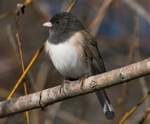
•*Dark-eyed Junco: YR, Very common in appropriate habitat around the county, including suburban settings. Regular feeder visitor. Arroyo Sierra Dr., Strawberry School Park, Ragel Ranch Park, Lake Ralphine, Spring Lake, Annadel State Park, Sugarloaf Ridge State Park, Sonoma State University campus, Helen Putnam Regional Park, Shollenberger park, Ellis Creek Water Treatment Facility (Pictured here)
•Slate-colored Junco: SVAR, sporadically observed at feeders (including my own). Has been seen at Arroyo Sierra Dr., Spring Lake

CARDINALS, PIRANGA TANAGERS, and ALLIES (Family Cardinalidae)
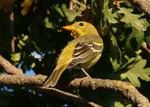
•*Western Tanager: Sum. Spring Lake, Sugarloaf Ridge State Park, sometimes in suburbs during spring and autumn migration. (Pictured here)
GROSBEAKS
•*Black-headed Grosbeak: Sum, common during the summer months in forested areas. Pine Flat Rd., Lake Ralphine, Spring Lake, Channel Dr., Santa Rosa Creek at Willowside Rd., Annadel State Park, Sugarloaf Ridge State Park
•Rose-breasted Grosbeak: SVAR, Sum, but rare. Reported at Santa Rosa Creek at Willowside Rd.(June 2010).
BUNTINGS
•*Lazuli Bunting: Sum, Wooded areas at higher elevations. Pine Flat Rd., Sugarloaf Ridge State Park, Hood Mountain, Crane Creek`Regional Park
•Indigo Bunting: SVAR, Sum, but rare. Pine Flat Rd. June 16-June 25, 2012. Seen at the Hole in the Head September 13-14, 2011. Turns up occasionally at Point Reyes, in neighboring Marin County.

BLACKBIRDS (Family Icteridae)
MEADOWLARKS
•*Western Meadowlark: YR, but becomes more common in Win, Shollenberger Park, Ellis Creek Water Treatment Facility, Laguna de Santa Rosa, Spring Lake, Port Sonoma Reclamation Rd.
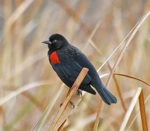
•*Brewer's Blackbird: YR, common around human habitation, parks, coastal areas. Bodega Head, Porto Bodega, Duncan's Landing, Tides Restaurant parking lot, Bodega Farm Pond, Laguna de Santa Rosa, Lake Ralphine, Spring Lake, Shollenberger Park
•*Red-winged Blackbird: YR, common around water throughout the county. Bodega Head, Hole in the Head, Campbell Cove, Bodega rail ponds, Laguna de Santa Rosa, Ragle Ranch Park, Lake Ralphine, Spring Lake, Shollenberger Park, Ellis Creek Water Treatment Facility (Pictured here)
•*Brown-headed Cowbird: YR, but more abundant in Sum. Often joins flocks of blackbirds, especially in the winter; hangs around cattle holding areas. Bodega Head, Porto Bodega, Santa Rosa Creek at Willowside Rd., Spring Lake, Sugarloaf Ridge State Park, Sonoma State University campus, Shollenberber Park
•Tricolored Blackbird: Sporadic, mostly Sum.
•Great-tailed Grackle: Place to Play Park (June 2012); Shollenberger Park (Aug, Sep, Nov, Dec, 2010), Ellis Creek Water Treatment Facility (Aug, Sep, Oct, Nov, 2010), Goat Rock (Apr. 2006)
•Yellow-headed Blackbird: SVAR. Bodega Head (2011), Rohnert Park, CA (May 2007)
ORIOLES
•*Bullock's Oriole: Sum, Santa Rosa Creek at Willowside Rd., Spring Lake, Sonoma State University Campus, Ellis Creek Water Treatment Facility
•*Hooded Oriole: Sum, Santa Rosa Creek at Willowside Rd., Spring Lake, Sonoma State University Campus,

FRINGILLINE and CARDUELLINE FINCHES and ALLIES (Family Fringillidae)
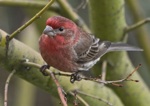
•*House Finch: YR, Very common in appropriate habitat throughout the county, including suburban settings. Regular feeder visitor. Bodega Bay area generally, Bodega Head, Arroyo Sierra Dr., Strawberry School Park, Ragel Ranch Park, Lake Ralphine, Spring Lake, Annadel State Park, Sonoma State University campus, Sugarloaf Ridge State Park, Hood Mountain, Shollenberger park, Ellis Creek Water Treatment Facility (Pictured here)
•*Lesser Goldfinch: YR, Very common in appropriate habitat around the county, including suburban settings. Regular feeder visitor (the single most common species at my own feeder). Bodega Bay area generally, Arroyo Sierra Dr., Strawberry School Park, Ragel Ranch Park, Laguna de Santa Rosa, Place to Play Park, Nagasawa Park, Lake Ralphine, Spring Lake, Annadel State Park, Sonoma State University campus, Sugarloaf Ridge State Park, Hood Mountain, Shollenberger park, Ellis Creek Water Treatment Facility, Helen Putnam Regional Park, Pine Flat Rd.
•*American Goldfinch: YR, common in appropriate habitat around the county, including suburban settings. Regular feeder visitor. Bodega Bay area generally, Hole in the Head, Santa Rosa Creek at Willowside Rd., Ragel Ranch Park, Place to Play Park, Nagasawa Park, Lake Ralphine, Spring Lake, Arroyo Sierra Dr. Annadel State Park, Sonoma State University campus, Hood Mountain, Shollenberger park, Ellis Creek Water Treatment Facility, Helen Putnam Regional Park
•*Pine Siskin: Win, occasional winter feeder visitor. Jenner (Willowside Rd.), Arroyo Sierra Dr., Annadel State Park, Shollenberger Park
•*Purple Finch: YR, but somewhat more common in Win. Occasional winter feeder visitor. Laguna de Santa Rosa, Spring Lake, Annadel State Park
•Evening Grosbeak: Irruptive. Sporadic visitor in spring and autumn, with some birds overwintering. Recent outbreak Dec. 2010, around Apollo Way in Santa Rosa
•*Lawrence's Goldfinch: SVAR, Sum, but rare. Has been seen at Pine Flat Rd., Pepperwood Ranch, Tolay Regional Park,
KEY
•Abundance: (Color coded to make it clear at a glance which birds are most common)
Common (Permanent resident or abundant seasonally)
Less common (usually present, or present in season, but not abundant)
Unusual (migrants present seasonally, but only for a short period or in small numbers; or birds that may be confined to a limited habitat)
Uncommon or Rare (One or only a few accepted county sightings, or birds that are noted only once or twice yearly).
Birds are listed in rough order of abundance within their groups.
•Seasonality: Winter (Win); Spring; Summer (Sum); Autumn; Year-round (YR); Sporadic, Vagrant, Accidental, or Rare (SVAR). Intended as a rough guide only--many "summer" birds, for example, arrive in early spring and leave in late autumn, and some may overwinter.
•Locations given are some of the most likely places to find each bird in the county (not exhaustive, and, obviously, birds will be found in places not listed here. Again, intended as a rough guide.)
*Birds marked with an asterisk are birds known to breed in Sonoma County, according to Sonoma County Breeding Bird Atlas (Betty Burridge, Ed., Madrone Audubon Society, 1995)
Also see NON-PASSERINES, PELAGIC SPECIES, and INTRODUCED SPECIES
© Colin Talcroft, 2009, 2010, 2011, 2012, 2013
Unless noted, all photos by the author. If you would like to use one of my images, please ask for permission for non-commercial use with proper credit or commercial use with proper compensation.
